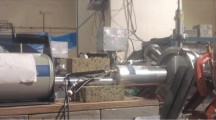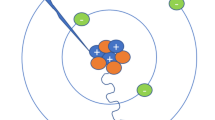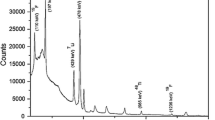Abstract
Lithium titanate, one of the important tritium breeding materials in D–T based fusion reactor under ITER programme, was synthesized through sol–gel route. For chemical quality control of finished product, it was necessary to quantify the lithium and titanium contents. As this ceramic sample is difficult to dissolve, non-destructive analytical methods are preferred for compositional analysis. In the present work, two non-destructive nuclear analytical methods namely particle induced gamma-ray emission (PIGE) using proton beam and instrumental neutron activation analysis (INAA) using reactor neutrons were standardized for the determination of lithium and titanium concentrations, respectively and applied to eleven samples of lithium titanate. To the best of our knowledge, Li quantification in lithium titanate sample is being reported for the first time using PIGE. For quantifications of Li and Ti, 478 keV prompt gamma-ray from 7Li (p, p′γ) 7Li and 320 keV gamma-ray from 50Ti (n,γ) 51Ti were measured, respectively, by high resolution gamma-ray spectrometry. The PIGE and INAA methods were validated using several synthetic samples containing lithium and titanium, respectively. Concentrations of lithium and titanium and Li/Ti mole ratios were evaluated and compared with the stoichiometric concentration of Li2TiO3.






Similar content being viewed by others
References
Roux N, Avon J, Floreancig A, Mougin J, Rasneur B, Ravel S (1996) J Nucl Mater 233–236:1431–1435
Gierszewski P, Miller J, Sullivan J, Verrall R, Earnshaw J, Ruth D, Macauley-Newcombe R, Williams G (2005) Fusion Eng Des 75–79:877–880
Giancarli L, Chuyanov V, Abdou M, Akiba M, Hong BG, Lässer R, Pan C, Strebkov Y, TBWG Team (2007) J Nucl Mater 367:1271–1280
Govindan R, Alamelu D, Shah RV, Vittal Rao TV, Bamankar YR, Parab AR, Sasi Bhushan K, Mukerjee SK, Aggarwal SK (2010) Anal Methods 2:1752–1755
Gierszewski P (1998) Fusion Eng Des 39–40:739–743
Tang Tao, Zhang Zhi, Luo Jian-Bo Meng De-Li (2009) Fusion Eng Des 84:2124–2130
Mandal D, Sathiyamoorthy D, Govardhana Rao V (2012) Fusion Eng Des 87:7–12
Vittal Rao TV, Bamankar YR, Mukerjee SK, Aggarwal SK (2012) J Nucl Mater 426:102–108
Li Yunjiao, Cang Xu, Wang Xuanyu, Li Lin, Kong Long (2012) Mater Lett 89:25–27
Pedarnig JD, Heitz J, Stehrer T, Praher B, Praher B, Viskup R, Siraj M, Moser A, Vlad A, Bodea MA, Bodea MA, Ba¨uerle D, Hari Babu N, Cardwell DA (2008) Spectrochim Acta B63:1117–1121
Chhillar S, Acharya R, Pai RV, Sodaye S, Mukerjee SK, Pujari PK (2012) J Radioanal Nucl Chem 293:437–441
Savidou A, Aslanoglou X, Paradellis T, Pilakouta M (1999) Nucl Instrum Methods B152:12–18
Mateus R, Jesus AP, Braizinha B, Cruz J, Pinto JV, Riberio JP (2002) Nucl Instrum Methods B190:117–121
Chhillar S, Acharya R, Sodaye S, Sudarshan K, Santra S, Mishra RK, Kaushik CP, Choudhury RK, Pujari PK (2012) J Radioanal Nucl Chem 294:115–119
Kiss ÃZ, Koltay E, Nyako B, Somorjai E, Antilla A, Räisäien JJ (1985) J Radioanal Nucl Chem 89:123–141
Šmit Z, Tartari F, Stamati F, Vevecka A, Priftaj, Istenic J (2013) Nucl Instrum Methods B296:7–13
Karamanis DT, Aslanoglou XA, Assimakopoulos PA, Gangas NH (1999) J Radioanal Nucl Chem 242:3–9
Volfinger M, Robert JL (1994) J Radioanal Nucl Chem 185:273–291
Havránek V, Kucera J, Randa Z, Vosecek V (2004) J Radioanal Nucl Chem 259:325–329
Samudralwar DL, Robertson LD (1993) J Radioanal Nucl Chem 169:259–267
Weicheng Zhang, Tianmei Zhang, Xiangguo Lei (1991) J Radioanal Nucl Chem 151:313–317
Habrioux A, Surblé S, Berger P, Khodja H, Affroux AD, Mailley S, Gutel T, Patoux S (2012) Nucl Instrum Methods B290:13–18
Mima K, Gonzalez-Arrabal R, Azuma H, Yamazaki A, Okuda C, Ukyo Y, Sawada H, Fujita K, Kato Y, Perlado JM, Nakai S (2012) Nucl Instrum Methods B290:79–84
Mateus R, Jesus AP, Fonseca M, Luis H, Ribeiro JP (2007) Nucl Instrum Methods B264:340–344
Mukhopadhyay PK (2001) Symposium on Intelligent Nuclear Instrumentation Mumbai (INIT-2001), Bhabha Atomic Research Centre, Mumbai, p 307
Izquierdo G, West AR (1980) Mater Res Bull 15:1655–1660
Acknowledgments
Authors thank Dr. A. Goswami, Head, RCD, BARC for his support and keen interest in this study. Authors thank Dr. P. Singh, Head, IADD, Mr. S. K. Gupta, Mr. A. Agarwal and other FOTIA crew members of IADD, BARC, Dr. S. Santra, NPD, BARC, Dr. R. Tripathi and Dr. S. Sodaye, RCD, BARC for their support and help during experimental work using PIGE.
Author information
Authors and Affiliations
Corresponding author
Rights and permissions
About this article
Cite this article
Chhillar, S., Acharya, R., Vittal Rao, T.V. et al. Non-destructive compositional analysis of sol–gel synthesized lithium titanate (Li2TiO3) by particle induced gamma-ray emission and instrumental neutron activation analysis. J Radioanal Nucl Chem 298, 1597–1603 (2013). https://doi.org/10.1007/s10967-013-2609-5
Received:
Published:
Issue Date:
DOI: https://doi.org/10.1007/s10967-013-2609-5




